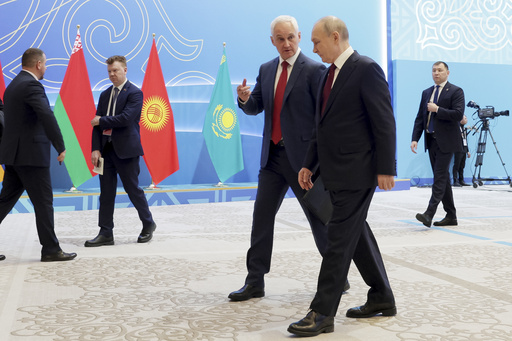Russia’s ruble is currently experiencing a decline against several global currencies, posing challenges for the Kremlin as it attempts to manage consumer inflation while simultaneously ramping up spending related to the ongoing conflict in Ukraine.
The central bank’s official exchange rate for the ruble was set at 109 rubles to the U.S. dollar recently, indicating that the ruble’s value is now less than one cent in dollar terms. After reaching a low of about 114 rubles to the dollar earlier in the week, the ruble has seen a slight recovery.
This depreciation is not limited to the dollar; the ruble has also weakened against the Chinese yuan. This shift comes as businesses in Russia increasingly turn to the yuan for foreign trade, largely due to sanctions from Western countries that have limited Russia’s access to transactions involving Western banks and financial institutions.
Residents of Moscow shared their perspectives on the ruble’s decline as the situation remains complex. One young woman, Yekaterina, who chose to remain anonymous, stated that she had recently made a deposit for her vacation in Egypt and expressed concerns about the remaining payment, yet she remained optimistic about domestic developments, saying, “For the Russian economy, it’s not too concerning. We are seeing progress in local tourism and industry.”
Another Moscovite, Semyon, expressed minimal concern over the fluctuating value of the ruble, focusing instead on his day-to-day transactions, noting, “My salary is in rubles, my taxes are in rubles, and my purchases are in rubles. I don’t see the necessity for dollars in my life.”
The Kremlin faces a balancing act, with increased government spending related to the war effort driving industrial production to high levels and fueling stronger economic growth than anticipated. However, this has also led to rising inflation, prompting the central bank to raise interest rates to a staggering 21% in an effort to curb spending and borrowing. This move has been met with criticism from businesses struggling with expenses tied to high-interest loans, leading many economists to predict that these conditions could eventually hinder economic growth.
President Vladimir Putin remarked that the ruble’s dip can be attributed to a combination of factors, including inflation, budget payments, and fluctuations in oil prices. He reassured the public, stating, “In general, I believe the situation is manageable, and there are no reasons for alarm.”
Despite this reassurance, the ruble’s performance and rising inflation continue to pose significant challenges for the government. Janis Kluge, an economist at the German Institute for Security and International Affairs, noted that inflation and currency exchange rates are particularly sensitive topics for the public. “These factors are very tangible and felt directly by citizens, making it difficult for any message to convince them that prices aren’t increasing when, indeed, they are,” he explained. Therefore, the Kremlin is keenly focused on inflation control.
A devalued ruble translates to higher costs for imports, particularly for essential goods such as cars and electronics imported from China, which has become Russia’s primary trading partner. The ruble has recently struggled, falling from levels around 85 to the dollar just a few months prior; this is largely due to weakened oil prices, reduced foreign investment, and the inflation rate contributing to the currency’s decreasing value against trading partners.
A significant factor in the recent ruble decline includes the U.S. Treasury’s sanctions targeting Gazprombank. This bank previously played a crucial role in facilitating Russia’s oil and gas transactions within Europe, and now the sanctions have blocked this vital source of foreign income, further intensifying pressures on the ruble and raising questions about Russia’s ability to adapt.
The unfavorable exchange rate isn’t entirely negative for the Kremlin, as it boosts government revenues from oil and gas exports when measured in ruble terms. At present, the central bank is endeavoring to stabilize the currency in the wake of the sanctions. Without open market trading for the ruble, the bank is adjusting rates based on perceived trade demands and cash inflow from exporters.
Chris Weafer, of Macro-Advisory Ltd, explained that the central bank controls the exchange rate, setting it based on the economic context and market needs. “Given the current restrictions, they have opted to allow the ruble to depreciate as this decision supports the finance ministry more effectively,” he stated. Looking ahead, the central bank will need to consider both inflation control and budgetary requirements to determine the most appropriate currency exchange rate, potentially necessitating higher currency conversion expectations from exporters.


